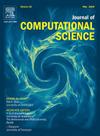CICN: Higher-order link prediction with clustering mutual information of common neighbors
IF 3.1
3区 计算机科学
Q2 COMPUTER SCIENCE, INTERDISCIPLINARY APPLICATIONS
引用次数: 0
Abstract
In complex networks, traditional link prediction focuses on pairwise interactions between node pairs to predict missing links and identify spurious interactions, which has a wide range of applications in the real world. However, with the continuous expansion of network scale, interactions within the network occur not only between pairs of nodes but also involve higher-order interactions among multiple nodes. However, traditional link prediction methods face challenges in directly predicting these higher-order structures. In this paper, we propose a novel higher-order link prediction method based on Clustering mutual Information of Common Neighbors (CICN) for the prediction of 3-cliques (triangles). CICN employs node information entropy and calculates the impact of common neighbors by integrating different-order clustering coefficients to predict 3-cliques in the network. Experiments on 9 empirical networks show that the higher-order clustering patterns of nodes can significantly improve the accuracy of predicting 3-cliques. Additionally, we investigate the stability of the proposed algorithm and the results indicate that the performance of the CICN remains favorable across training sets of varying sizes. The source codes of our method are publicly available at: https://github.com/yabingyao/CICN4HigherOrderLinkPrediction.
CICN:基于共同邻域互信息聚类的高阶链路预测
在复杂网络中,传统的链路预测侧重于通过节点对之间的成对交互来预测缺失链路和识别虚假交互,在现实世界中有着广泛的应用。然而,随着网络规模的不断扩大,网络内部的交互不仅发生在节点对之间,还涉及到多个节点之间的高阶交互。然而,传统的链路预测方法在直接预测这些高阶结构时面临着挑战。本文提出了一种基于共同邻居聚类互信息(CICN)的高阶链路预测方法,用于3-cliques(三角形)的预测。CICN利用节点信息熵,通过积分不同阶聚类系数来计算共同邻居的影响,预测网络中的3-cliques。在9个经验网络上的实验表明,节点的高阶聚类模式可以显著提高3-cliques预测的准确性。此外,我们研究了所提出算法的稳定性,结果表明,在不同大小的训练集上,CICN的性能仍然良好。我们的方法的源代码可以在:https://github.com/yabingyao/CICN4HigherOrderLinkPrediction上公开获得。
本文章由计算机程序翻译,如有差异,请以英文原文为准。
求助全文
约1分钟内获得全文
求助全文
来源期刊

Journal of Computational Science
COMPUTER SCIENCE, INTERDISCIPLINARY APPLICATIONS-COMPUTER SCIENCE, THEORY & METHODS
CiteScore
5.50
自引率
3.00%
发文量
227
审稿时长
41 days
期刊介绍:
Computational Science is a rapidly growing multi- and interdisciplinary field that uses advanced computing and data analysis to understand and solve complex problems. It has reached a level of predictive capability that now firmly complements the traditional pillars of experimentation and theory.
The recent advances in experimental techniques such as detectors, on-line sensor networks and high-resolution imaging techniques, have opened up new windows into physical and biological processes at many levels of detail. The resulting data explosion allows for detailed data driven modeling and simulation.
This new discipline in science combines computational thinking, modern computational methods, devices and collateral technologies to address problems far beyond the scope of traditional numerical methods.
Computational science typically unifies three distinct elements:
• Modeling, Algorithms and Simulations (e.g. numerical and non-numerical, discrete and continuous);
• Software developed to solve science (e.g., biological, physical, and social), engineering, medicine, and humanities problems;
• Computer and information science that develops and optimizes the advanced system hardware, software, networking, and data management components (e.g. problem solving environments).
 求助内容:
求助内容: 应助结果提醒方式:
应助结果提醒方式:


